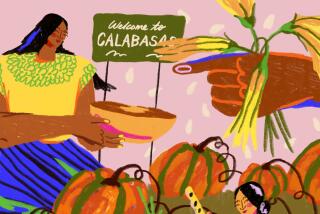Study Puts Roots of Farming in West at 8000 BC
A handful of squash seeds and a bit of rind from a Mexican cave are rewriting the saga of one of the most important turning points in the history of humans in the Americas--the development of farming.
Dating of the seeds indicates that domestic cultivation of plants in this hemisphere began about 10,000 years ago--more than 4,000 years earlier than scientists had believed. That would make the development of farming contemporaneous with the earliest agriculture in China and the Middle East, according to a report today in the journal Science.
The finding suggests that most primitive societies developed this important concept at the same time--that agriculture was simply “an idea whose time had come,” said archeologist Bruce Smith of the Smithsonian Institution, the report’s author.
“There is a philosophical argument about whether there were only a few smart humans, who passed their ideas along, or whether humans in many different areas came up with the same ideas, like agriculture and fire,” said archeobotanist Dina Decker-Walters of the Fairchild Tropical Gardens in Miami. “What we are finding out more and more is that human species seemed to evolve along similar lines wherever they were located.”
“We have to ask why” agriculture suddenly sprang up, said archeologist Kent Flannery of the University of Michigan. “Humans have lived on this Earth for 2.5 million years and had lived for hundreds of thousands of years as hunter-gatherers. Why, in the space of 5,000 years, did agriculture appear independently in seven areas of the world?”
Flannery believes that changes in the environment, particularly changes in climate at the end of the ice age, “challenged humans to come up with more complex strategies for earning a living.” But the bottom line, he added, is that nobody yet knows why humans everywhere suddenly began planting crops.
The discovery also poses a new quandary for researchers. Although it has been widely accepted that hunter-gatherer societies quickly convert to agricultural ones once the first crop is planted, that transition apparently took an unprecedented 6,000 years on this continent. One possible explanation is that settlements capable of sustaining agriculture occurred much later in this hemisphere.
“In the rest of the world, villages predated agriculture,” Flannery said. “On this continent, agriculture preceded villages”--perhaps by as much as 8,500 years.
In other parts of the world, wild crops such as barley or rice could support large numbers of people. In the Middle East, villages sprang up near barley patches long before humans began planting the crop on their own--perhaps 12,000 years ago or more.
But that was not the case in North America, Flannery and Decker-Walters agreed. No wild crops could support a settlement, and the domestication of squash did not change the equation. The only edible parts of the first squash were the seeds, which were nutritious but not very filling. Mesoamericans probably prized them for their hollowness and ability to carry water and other foods more than for their food value.
Although squash was a useful adjunct to their lives, North Americans “were still practicing their old hunting, gathering, and fishing ways,” said archeologist Gayle Fritz of Washington University in St. Louis.
Even the first cultivation of corn 4,500 years ago or so did not change that situation. The first corncobs were the size of the filter on a filter-tipped cigarette, Flannery said. It was not until the cobs were the size of a man’s thumb, probably around 1500 BC, that a crop was able to support the first villages.
And it was not until the cobs were the size they are today that crops were able to support the sophisticated empires that greeted Columbus and the conquistadors.
The squash seeds that Smith studied have actually been stored in a museum for more than three decades. Flannery, who was then at the Smithsonian, discovered them in 1964 in a cave called Guila Naquitz, or White Cliff, in Oaxaca, Mexico. He and other researchers also found corncobs and beans in four other caves in the same general area.
Dating of the seeds by relatively crude methods available then showed them to be about 9,000 years old, but many archeologists disputed that date. Others argued that the seeds were from wild plants rather than domesticated ones.
In the last few years, researchers have used more sophisticated techniques to date seeds from the other caves. They found that the corncobs and beans were no more than 5,500 years old, considerably younger than Flannery and others had said.
Many researchers, Smith foremost among them, believed that the squash seeds would also prove to be younger than Flannery had said. Recent articles have carried titles such as “Are the First American Farmers Getting Younger?”
To settle the issue, Smith last year went to the Instituto Nacional de Antropologia e Historia in Mexico City to study the squash samples. Among other things, he studied their shape and size.
When people deliberately plant seeds in prepared garden beds, they establish a new set of rules for survival and success to which plants automatically respond. One rule favors plants that produce larger seeds because young plants that have larger start-up food reserves--that is, bigger seeds--can grow more quickly and leave their competitors in the shade. This increases their chance of being harvested.
Smith concluded that the squash seeds, which were bigger than seeds from wild plants, were clearly domesticated. Another indication was that a fragment of rind from one squash was orange, unlike rind from wild plants, which is white.
He then used a razor to shave off thin slices for dating. To his surprise, the results proved them to be 10,000 years old.
“That means Mexico moves right back, pretty close to the Near East and China in terms of temporal precedence,” Smith said. Humans began domesticating barley in the Jordan River valley and rice in China about 10,000 to 11,000 years ago.






